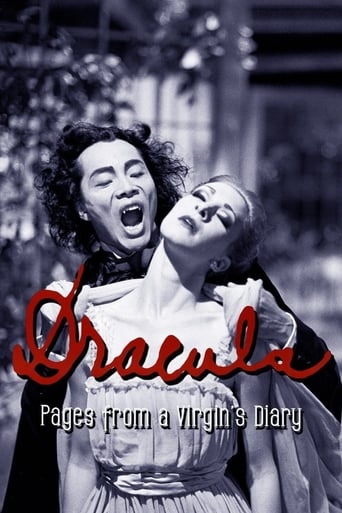jacobjohntaylor1
This is ballet based on Dracula. Dracula is one of the my favourite horror stories. So I really enjoy this movie. It is very scary. It has great story line. I has great dancing. It has great music. If you what to see a great vampire movie. This is the one to see. Wei-Qiang Zhang is great has Dracula. He is a great actor. He is very scary. David Moroni is a great actor. 7 is under rating it. It is a 9. This movie very different. This movie is must see. It is based on one of the best horror books ever. And it is one of the best horror movies ever. Johnny A Wright is a great actor. This is one the best remakes of all time. 9 out of 10. This is a great film.
moviemanMA
I really had no idea what to expect coming into this film. I had heard basically nothing about it other than it's good ratings, recommendation from Ebert, and I have been interested for a while now in Guy Maddin. This is my first time watching one of his films and I am borderline speechless. I didn't know he primarily works in the silent genre and to top that, this film is entirely a ballet. Filmed in mostly black and white with silent era techniques, Maddin creates and eerie mood with this take on Brom Stoker's classic novel. I've never seen anything quite like it. It sometimes looks like it from the silent era. It's impressive. My one complaint is the jumpy nature of the camera. I was sometimes focused on his dizzying camera work than what was going on, but still a very refreshing and awakening experience.
OldAle1
Maddin's first feature-length commissioned work that he didn't originate, and in this case didn't write either. Very different stylistically from the following film ("Cowards Bend the Knee"), this is the film of a ballet by Mark Godden for the Royal Winnipeg Ballet, based on Bram Stoker's novel, with music taken from Gustav Mahler's first and second symphonies. Not typical Maddin material at first glance perhaps but the psychosexual nature of the Dracula story melds surprisingly well with Maddin's aesthetic, offering a more dreamlike and romantic vampire tale than usual, but also one in which the violence and hatred in the bigoted Victorian English men who confront the vampire is made almost as explicit as Dracula's own hunger.I'm not going to go into any great detail about the story, as it follows the fairly typical Dracula pattern; suffice it to say that young Lucy Westernra (Tara Birtwhistle) is seduced by Dracula, turns vampire and is ultimately killed; her husband-to-be has enlisted the aid of Van Helsing (David Moroni) who tracks Dracula to his lair by means of a new potential victim, Mina (CindyMarie Small) being used as bait. Finally, a confrontation between the lord of the night (Wei-Qiang Zhang) and Van Helsing's group ensues in the vampire's underground abode.This is very different-looking from the succeeding film, indeed rather different from any of the director's other films. Much of the film is shot in sharp and crisp 35MM as opposed to his more usual super-8 and 16mm (though I believe he uses some of those as well), many of the shots are longer and more fluid, and there is a dramatic use of color, digitally painted on in just a few bold strokes - red blood on the neck, Dracula's bold and frighteningly large red cloak, green money, yellow digital titles. The longer, more "balletic" and graceful shots contrast strongly with the rapid cutting in the action scenes and really help to highlight the sense of fear and unearthliness, and the casting of a Chinese-Canadian as the dreaded count emphasizes the xenophobia inherent in the novel and in the Victorian mindset generally.Gustav Mahler was a rough contemporary of Stoker's, and his first two symphonies premiered in the early 1890s roughly when Stoker was writing Dracula. I've been a huge fan of Mahler for years and at first I wondered how appropriate these works would be, but they fit this work almost like a glove - the glory of nature expressed in the first movement of the first symphony perfectly expresses the freedom that this bold, sexual and luminous being Dracula brings to the young repressed maidens of stuffy English society, and the "Resurrection" symphony (the second) is perfectly appropriate to many of the themes inherent in the vampire story. Also, their placement as late romantic works on the cusp of modernity seems to jibe well with Maddin and Godden's vision of Dracula as a 20th century, threatening, alien creature who may offer promise and a bold and liberated way in the world, but who the world is just not ready for.Beautifully and expressively dance, wonderfully shot and edited, if there's a problem here it's that Maddin's trademark strange humor seems to me at times a little out of place -- many of the titles are deliberately exaggerated, particularly at the beginning of the film. But this is a small qualm, and the beauties and emotional power of the story soon leave the few goofy elements behind. Gorgeous and visionary and proof that Maddin can do quite well with someone else's ideas to work from.
bloodaxe-2
I enjoy ballet, and I like vampire films (especially the old ones), so why did this just not work for me? Well, I seemed to spend most of my time distracted by the dancing, or rather by the fact that the dancing was so difficult to watch because the dancers' feet were so seldom shown.I know these days showing off camera technique is considered more important than enabling audiences to get a proper look at the skills of dancers, ice skaters and gymnasts, who regularly seem to get the relevant parts of their bodies cut off on TV, but it does limit one's enjoyment.



